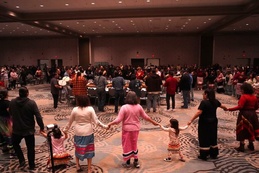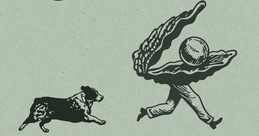
Sugar on Tap
How to Make Your Own Maple Syrup
By Emily Burke | March 19, 2022
There is no sweeter reward for making it through the long, dark NoMi winters than the scent of maple sap boiling away on its way to becoming maple syrup. Equal parts art and science, the whole sap-to-syrup process may seem complicated. “Many people are afraid to produce syrup because it looks intimidating,” says Interpreter Keith Knecht of the Cheboygan-based Native Ways Traditional Arts.
However, with a little know-how and patience, this time-honored northern tradition is easily one of the best ways to beat any lingering winter blues and welcome spring, all while bringing home an enviable haul.
Why the Sap Runs
The magic happens during the transition from winter to spring when the nighttime temperature falls below freezing and the daytime temperature warms to above freezing. Due to a physiological quirk in maples (and a few other species like black walnuts) the freezing and thawing cycle causes gas bubbles to form in the sap. These gas bubbles expand with warmer temperatures in the day, creating a positive pressure gradient that causes sap to move from the roots to the canopy, where buds use the energy to finish their development in time for blooming and leaf out. Lucky for sugarmakers, this extra daytime pressure also means that sap will flow out of a tap!
How to Tap a Tree
As long as the tree is at least 10 inches in diameter, both maples native to northern Michigan—red maple and sugar maple—can be used to make syrup, but, as its name suggests, sugar maples are preferred due to their sap’s slightly higher sugar content. At its most basic, tapping involves drilling a hole into a tree, pounding in a tap (also called a spile), and hanging a bucket or bag to catch the dripping sap. Each tap produces enough sap over the season to make about a quart of syrup.
Using a cordless drill (or in Knecht’s case, a brace and bit), sugarmakers make a hole 1 1/2 to 2 inches deep into the tree, drilling at a slight upward angle—“two to three degrees is more than enough,” says Knecht—to help the sap flow out of the hole. Next, a metal spile is pounded into the hole with a rubber mallet or hammer. Buckets and bags are usually hung from the spiles on hooks, but larger buckets can also be placed on the ground below the tap with plastic tubing connecting them to the spile. Other supplies include bucket covers to keep out rain and snow and a large food-grade barrel or reservoir to store sap in as buckets fill.
Making Syrup from Sap
The ratio of sap to syrup is, on average, 40:1, meaning that sap must be boiled for a long time in order to evaporate off enough water to turn it into syrup. While there are many boiling setups, the most important consideration is a boiling pan with a large surface area, which will help cut down on boiling time. Knecht, who has been producing maple syrup since 2011, notes that most of his sap is cooked down in a large evaporator (a specialized device that integrates a heating element below with a large pan on top), but a roasting pan set over an outdoor fire, a propane camp stove, or even a turkey fryer are also effective.
Above all, sugarmakers must be hearty: Unless you have a sugar shack, all boiling takes place outside in the early spring chill, as the amount of steam created from hours of boiling inside is enough to make your wallpaper peel off or ruin other household items!
Sap is continually added to the pan throughout the boiling process. Once all the sap has been boiled down to a point where it is noticeably thicker than water, sugarmakers bring the almost-syrup inside to finish on a stove, where the temperature can be controlled more easily.
Once inside, the liquid is typically filtered to remove any impurities—cheesecloth works well—and then boiled to achieve perfect density in a process referred to as finishing. Sugarmakers aim for a Brix reading of 66-66.9, meaning that the syrup is 66-66.9 percent sugar. The Brix of finishing syrup is measured indirectly by measuring density (which is a proxy for sugar content) with a hydrometer. Alternatively, because perfect-density maple syrup boils at exactly 219.2 degrees Fahrenheit, a candy thermometer can also be used.
Once the syrup reaches perfect density, it’s time for bottling. Any food-grade container will work as long as it’s new and clean, but home syrup-makers generally lean on good old Mason jars. Storing syrup jars in a cool, dry place will ensure that they remain fresh for at least a year, just in time for the next season of liquid gold.
Other Maple Goodness
While syrup is definitely the most well-known, maple sap is also processed into maple candy, maple cream, and maple sugar. “For the native people,” notes Knecht, “maple sugar was the order of the day, as syrup was too hard to store and transport.” This product simply requires a bit more boiling time beyond the syrup stage—until the mixture reaches 260°F, to be exact—and stirring with a paddle to create a granulated texture. The stirring process is Knecht’s favorite part because “it’s amazing to watch it go from a thick wet peanut butter consistency to a fine grain sugar.”
See the Magic in Action
This coming weekend is northern lower Michigan’s “Maple Weekend” and a prime time to celebrate syrup season. Check out one (or a few!) of these events across the region to get your fix and purchase maple syrup and sugar.
Southwell Sugar Shack
4700 Croy Lake Rd NE in Mancelona | Saturday, March 26, from 10am to 4pm
The annual Maple Open House is back! Tour this commercial-level maple syrup production facility, meet the sugarmakers, and sample a variety of maple goodies.
Native Ways Traditional Arts
2152 Cassidy Rd in Levering | Saturday, March 26, from 10am to 4pm
Interpreter Keith Knecht will demonstrate the production of maple sugar as it was done hundreds of years ago by Native Americans. Sap is collected in birchbark containers, reduced in kettles, and finished into sugar by hand graining in a wooden trencher.
Owl Ridge Maple Sugar Farm
3186 Sliverville Rd in Frankfort | Saturday, March 26, and Sunday, March 27, from 11am to 4pm
At this two-day open house, bring the whole family to see the evaporator going at full steam in the sugar house, then walk the beautiful self-guided trail down through the valley and over the ridge to see the sap collection in action.
Trending

Our Top Stories of 2025
Each year, we look back at the stories we’ve shared over the last 12 months and pull together the ones that got the mo… Read More >>
A Solo Rattler
Frontman of folk-rock band Michigan Rattlers Graham Young brings his solo performance to Great Lakes Center for the Arts in … Read More >>
GTB Starting the Year with Tradition
The Grand Traverse Band of Ottawa and Chippewa Indians hosts the Kchi Wiikwedong Anishinaabek Maawnjidowin Round Dance on Ja… Read More >>


